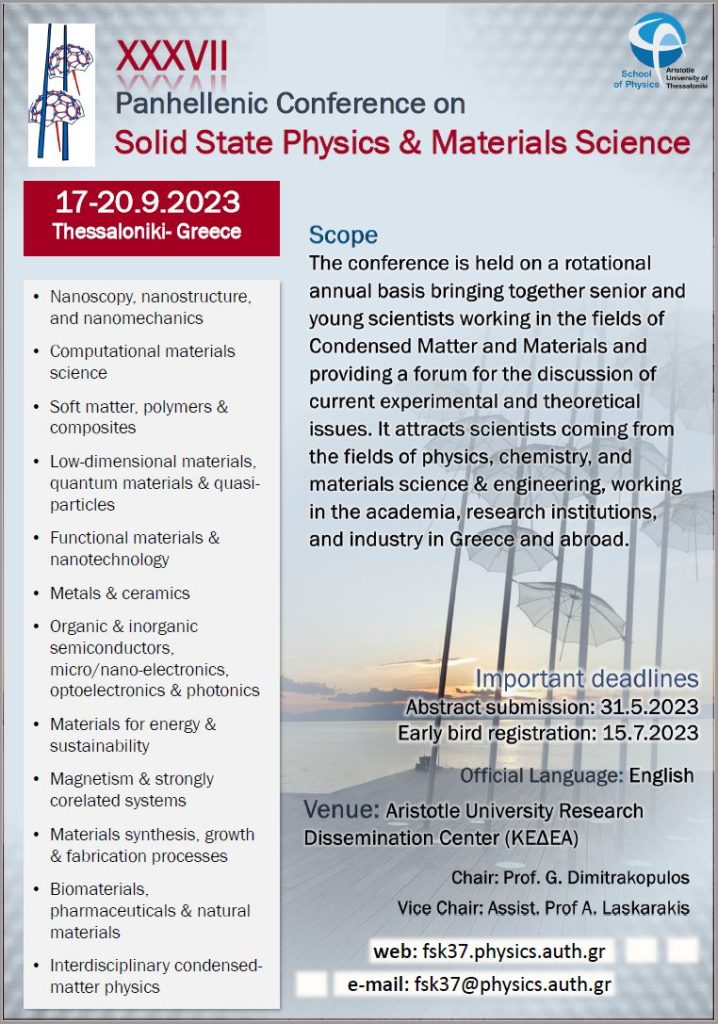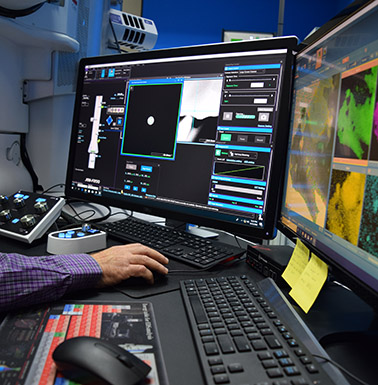Our latest posts
Workshop Announcement

We are thrilled to announce the upcoming workshop titled ATMATEN – From Atoms to Materials with Electron Nanoscopy, taking place in Thessaloniki on September 28th and 29th, 2024.
ATMATEN aims to bring together researchers, scientists, and professionals in the field of electron nanoscopy and materials science to explore the latest advancements and breakthroughs in the manipulation and understanding of materials at the atomic level.
Call for Participation: We invite researchers, scientists, engineers, and students with an interest in electron nanoscopy and materials science to participate in ATMATEN. Whether you are an established professional or an early-career enthusiast, this workshop offers a valuable platform to exchange ideas, collaborate, and broaden your understanding of this dynamic field.
Registration: Registration details and further information will be available soon on our website https:\\atmaten.physics.auth.
Don’t miss this opportunity to delve into the fascinating world of electron nanoscopy and materials science at ATMATEN. Mark your calendars and join us in Thessaloniki for an enriching experience!
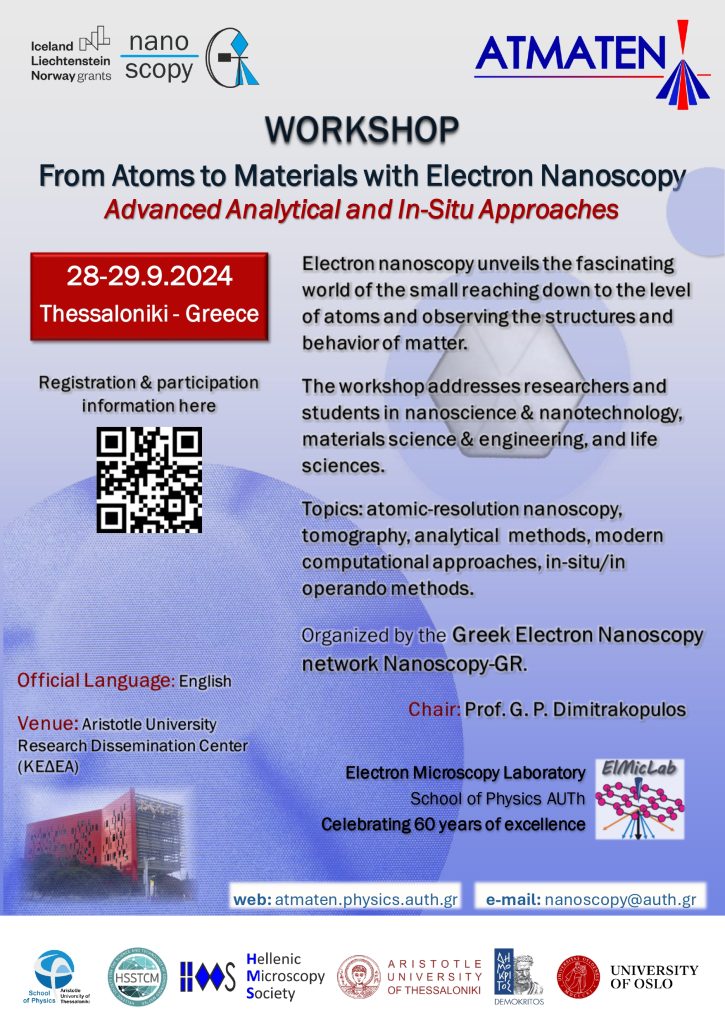
Webinars April 2024
In Situ and Operando Electron Microscopy: Exploring Real-Time Nanoscale Phenomena
Scope and Future Dissemination Activities
George Dimitrakopulos
Website: https://bit.ly/3pI5dC7
Google Scholar: https://scholar.google.com/citations?user=iN7UNvcAAAAJ&hl=en
Let’s connect
Twitter: https://bit.ly/453zH1C
Linked-In: https://bit.ly/3MuqlEN
Facebook: https://bit.ly/3IavRtB
Email: nanoscopy@auth.gr
Supported by: EEA Grants Greece https://bit.ly/3O8aRHY
In situ growth and operando (S)TEM investigation of 2D anodes for all-solid-state Li-ion batteries
Calliope Bazioti
Website:https://www.mn.uio.no/smn/english/people/aca/kalliopb/
Google Scholar: https://scholar.google.com/citations?user=3PSyRqAAAAAJ&hl=en
Let’s connect
Twitter: https://bit.ly/453zH1C
Linked-In: https://bit.ly/3MuqlEN
Facebook: https://bit.ly/3IavRtB
Email: nanoscopy@auth.gr
Supported by: EEA Grants Greece https://bit.ly/3O8aRHY
Bridging the pressure gap in TEM
Patricia J. Kooyman
Website: https://ebe.uct.ac.za/department-chemical-engineering/about-us-staff-academic-staff/patricia-j-kooyman
Google Scholar: https://scholar.google.co.za/citations?user=SqrrO24AAAAJ&hl=en
Let’s connect
Twitter: https://bit.ly/453zH1C
Linked-In: https://bit.ly/3MuqlEN
Facebook: https://bit.ly/3IavRtB
Email: nanoscopy@auth.gr
Supported by: EEA Grants Greece https://bit.ly/3O8aRHY
Nanofluidic Electron Microscopy
Kristian S. Mølhave
Website: https://orbit.dtu.dk/en/persons/kristian-speranza-m%C3%B8lhave
Google Scholar: https://scholar.google.com/citations?user=zi4IMBwAAAAJ&hl=en
Let’s connect
Twitter: https://bit.ly/453zH1C
Linked-In: https://bit.ly/3MuqlEN
Facebook: https://bit.ly/3IavRtB
Email: nanoscopy@auth.gr
Supported by: EEA Grants Greece https://bit.ly/3O8aRHY
WEBINAR
“In Situ and Operando Electron Microscopy: Exploring Real-Time Nanoscale Phenomena”
The lab network Nanoscopy-GR is organizing a webinar on:
” In Situ and Operando Electron Microscopy: Exploring Real-Time Nanoscale Phenomena “
on Thursday 11 April 2024 (start time 11:00 EEST)
The zoom link is: https://authgr.zoom.us/j/97017181612?pwd=VTQ1bEVPSmxVbEFsaG16UE1ENmNmdz09
Passcode: 201631
In situ and in operando electron microscopy are powerful techniques that allow scientists to observe the behavior of matter under real-world conditions. Unlike traditional electron micro-/nanoscopy, where samples are static and in vacuum, these methods introduce gases, liquids, or electrical fields, temperature variations, and mechanical stresses, while the microscope is running. This enables researchers to see how materials change with temperature, during chemical reactions, or under electrical or mechanical stress. This real-time information is crucial for developing new materials and understanding materials function at an atomic level. In the webinar, modern developments and application of in situ/operando electron micro/nanoscopy will be presented by distinguished researchers.
The webinar is organized under the support of EEA Grants Greece.
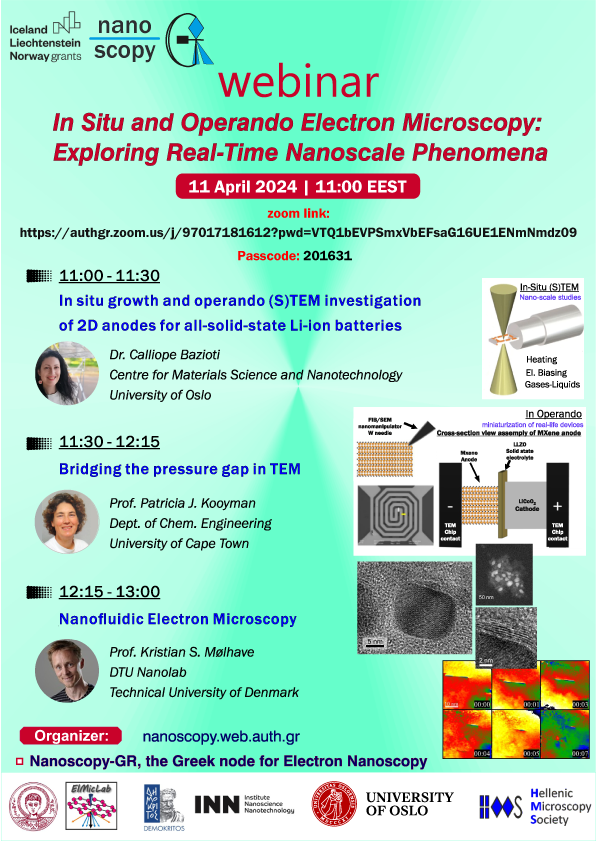
Scientific session on “Nanoscopy, Nanostructure and Nanomechanics“
during the 37th Panhellenic Conference on Solid State Physics & Materials Science September 2023
Tutorial Event September 2023
Nanoscopy-GR network organize a scentific session on Electron Nanoscopy during the 37th Panhllenic Conference on Solid State Physics & Materials Science.
Modern advances and capacities of electron nanoscopy for materials characterization
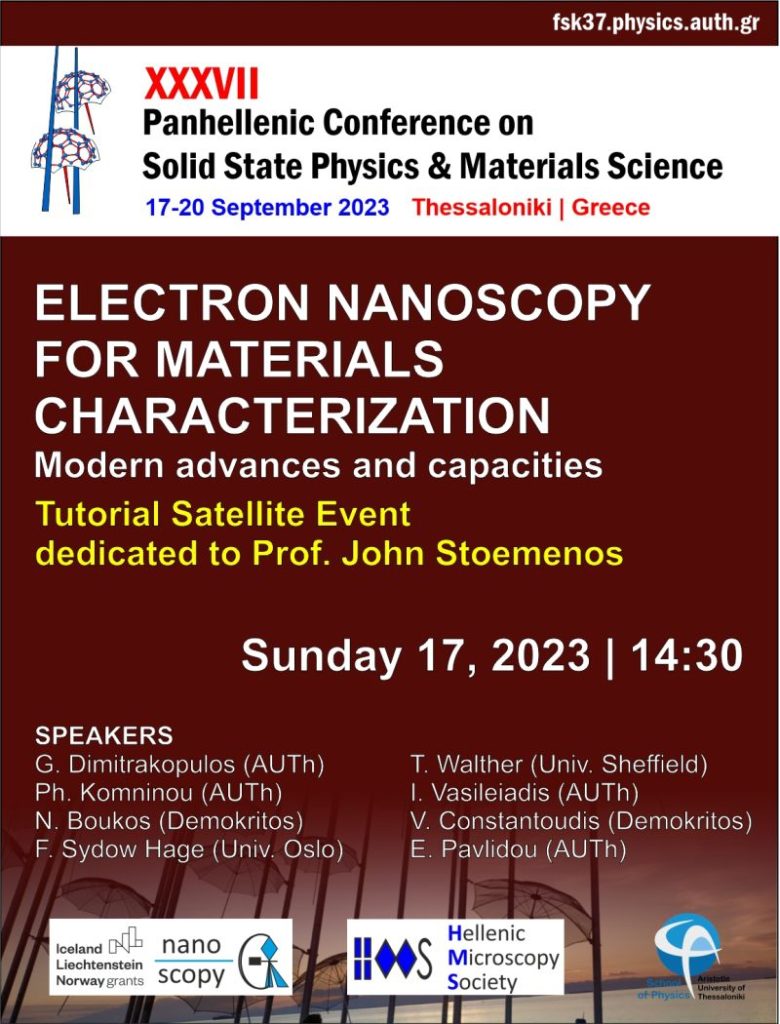
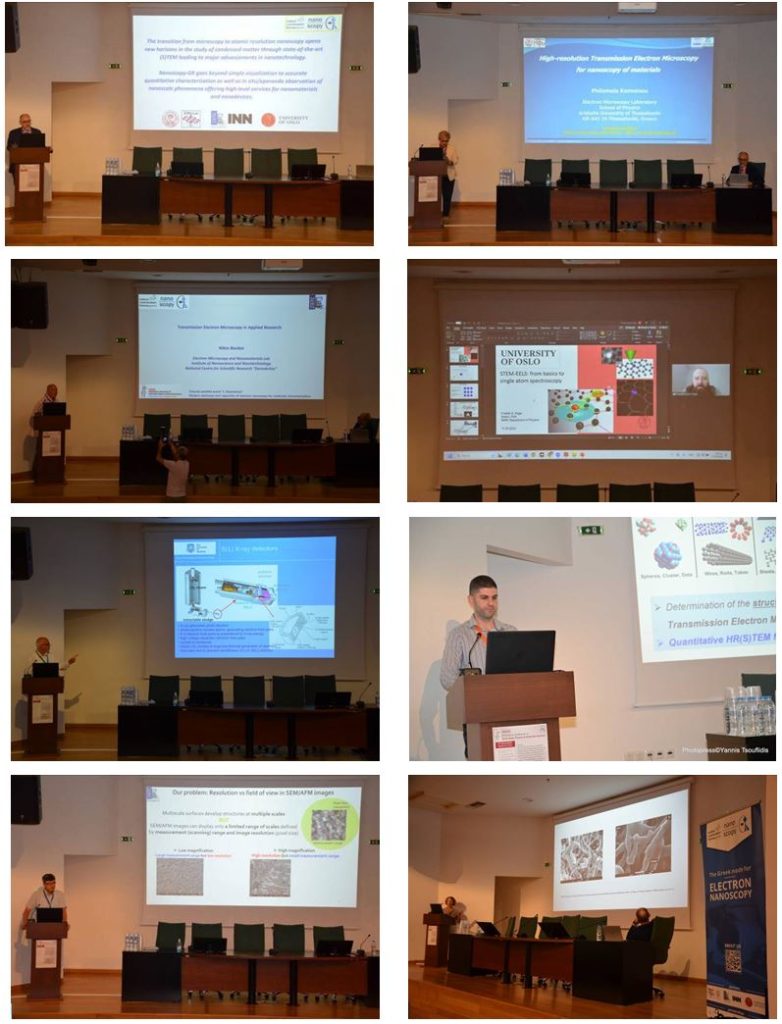

Webinars July 2023
The art of measuring at the nanoscale
The art of measuring at the nanoscale: Mastering quantitative atomic-resolution STEM – PART I
This is the first part of a webinar discussing about quantitative analysis for direct and accurate determination of atomistic structure and composition by high-resolution transmission and scanning-transmission electron microscopy [HR(S)TEM]. First a primer on the necessity of topological analysis for the study of structural defects and interfaces is given. Quantitative HR(S)TEM analysis includes the compositional determination from HAADF images, the accurate positional determination of projected atomic columns using HRTEM and nanoscale methods for strain measurements, complemented by finite element analysis of nanostructures.
George Dimitrakopulos:
Website: https://bit.ly/3pI5dC7
ResearchGate: https://bit.ly/42IiGsg
Supported by: EEA Grants Greece https://bit.ly/3O8aRHY
The art of measuring at the nanoscale: Mastering quantitative atomic-resolution STEM – PART II
In Part II of the webinar, the detailed methodological approach for quantitative HR(S)TEM analysis of complex nanostructures is discussed through two case studies: 1) The composition-strain coupling in ultra-thin InGaN/GaN quantum wells, and 2) the structure and mobility of partial dislocations in GaN. You can learn how the image intensity is quantified into composition, through a combination of image processing techniques and HRSTEM image simulations and how image simulations provide us with the appropriate conditions for the observation of dislocation cores by HRTEM.
Isaak Vasileiadis:
ResearchGate: https://www.researchgate.net/profile/…
Supported by: EEA Grants Greece https://bit.ly/3O8aRHY
Online practical training on ARTEMIS: AtomicResolution Transmission Electron Microscopy Imaging Software
Introducing A R T E M I S, an advanced image analysis tool developed by Elmiclab-AUTh. Designed with a user-friendly interface, using the MATLAB app designer, ARTEMIS allows for the accurate analysis of high resolution transmission and scanning-transmission images. With its comprehensive range of analytical tools, this software enables precise quantitative analysis of atomistic structure, composition and strain from HR(S)TEM images. It also includes several crystallographic tools to make the life of the experimentalist easier. No programming experience is required.
Isaak Vasileiadis:
ResearchGate: https://www.researchgate.net/profile/…
Supported by: EEA Grants Greece https://bit.ly/3O8aRHY
Nanoscopy-GR is delighted to unveil a webinar focusing on The Art of Measuring at the Nanoscale, will be held on July 19, 2023.
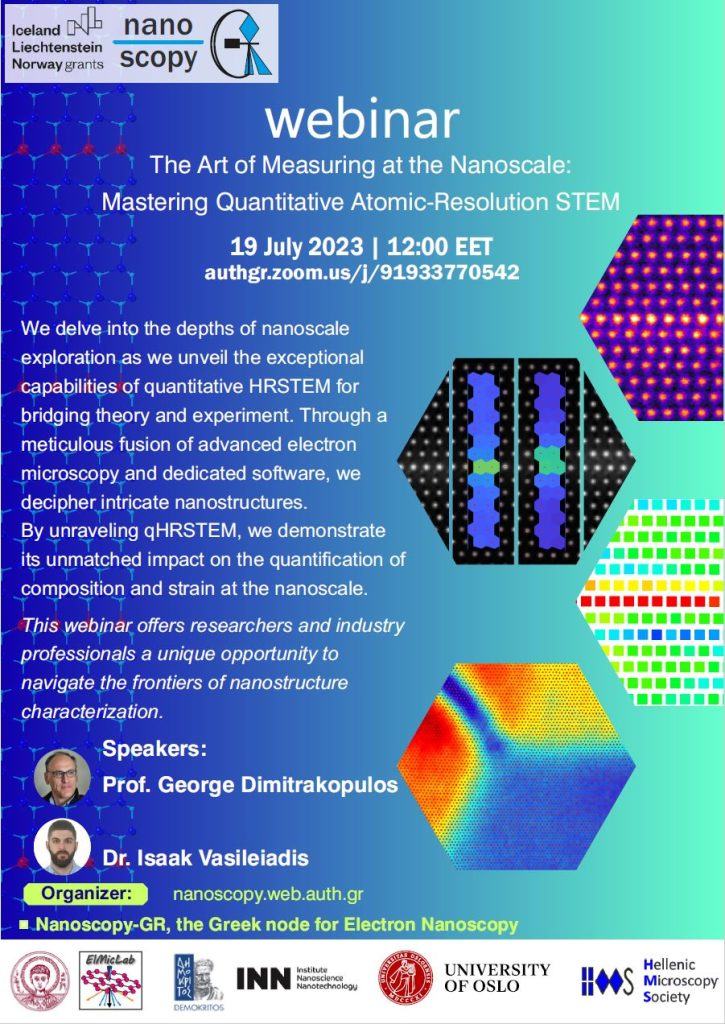
Webinars April 2023
Electron Nanoscopy and structural characterization of novel materials: Prospects and Opportunities for applied research
Introduction: Scope of the Nanoscopy-GR network
This is a brief introduction to electron Nanoscopy and the scope of the Nanoscopy-GR network.
George Dimitrakopulos:
Website: https://bit.ly/3pI5dC7
ResearchGate: https://bit.ly/42IiGsg
Supported by: EEA Grants Greece https://bit.ly/3O8aRHY
Transmission and Scanning/Transmission Electron Microscopy and Nanoscopy. Basic Principles, high resolution and modern capacities
This webinar introduces Electron Microscopy/Nanoscopy techniques and briefly describes the Electron Microscopy Laboratory (ElMicLab) at the Aristotle University of Thessaloniki (AUTh).
What are transmission electron microscopy (TEM) and Scanning-TEM (STEM)?
How does an electron microscope work? What are the key issues of our studies?
This presentation offers a sneak peek into what we do, from routine operation to elaborate (S)TEM-based techniques, including strain mapping and strain-composition coupling, with characteristic examples in nanoparticles, nanowires, 2D materials, and superlattices.
Philomela Komninou:
ResearchGate: https://bit.ly/42CPGlR ElmicLab: https://elmiclab.web.auth.gr
Supported by: EEA Grants Greece https://bit.ly/3O8aRHY
Electron Nanoscopy in applied research
Electron Nanoscopy, that is (Scanning) Transmission Electron Microscopy and associated analytical techniques such as Electron Energy Loss Spectroscopy and Energy Dispersive X-ray Spectroscopy, has proven to be an indispensable tool for the development and optimization of materials, processes and devices. During this webinar designated applied research activities of the Electron Microscopy and Nanomaterials Laboratory (EMNL) of the National Centre for Scientific Research “Demokritos” are presented. In particular selected case-studies are discussed to demonstrate what analytical (S)TEM techniques can offer in the fields of pharmaceuticals, oil refinement and nanometrology.
Nikos Boukos:
ResearchGate: https://bit.ly/3BwwBWi EMNL: https://inn.demokritos.gr/research_group/eman/
Supported by: EEA Grants Greece https://bit.ly/3O8aRHY
Spectroscopic and in situ/operando investigations of energy materials at the nanoscale
Analytical STEM, and especially EELS (Electron Energy Loss Spectroscopy), is crucial for materials characterization as it offers valuable insights into the elemental composition, chemical bonding, and electronic properties of materials at the nanoscale. Analytical STEM, in combination with in-situ and in-operando studies, is a robust tool that allows for real-time and dynamic observations of materials under various environmental conditions, enabling a deeper understanding of their behavior, transformations, and performance. This webinar provides insights into these topics and a demonstration of the activities of the Centre for Materials Science and Nanotechnology (SMN) of the University of Oslo that specializes in these techniques.
Calliope Bazioti:
Website: https://bit.ly/3o28dJb
ResearchGate: https://bit.ly/3pB9veq SMN: https://www.mn.uio.no/smn/
Supported by: EEA Grants Greece https://bit.ly/3O8aRHY
Computational methods and synergy with nanoscopy towards an integrated approach: Basic methodologies, new trends and effective interfacing
Computational Atomistic Condensed Matter Physics is a subfield of condensed matter physics that uses computational methods to study the properties of materials at the atomic scale. It seeks to understand the microscopic interactions of matter at the quantum and atomistic levels and describes how these interactions result in both mesoscopic and macroscopic properties. Computational atomistic condensed-matter physics is a growing area in which the development of sophisticated scientific software, design, modelling, and algorithms are all emphasized. Synergy between computational atomistic simulations and electron nanoscopy is crucial and bidirectional, since the latter can provide experimental data that guides computational simulations as well as the former can predict physical properties and phenomena that electron nanoscopy will validate. This talk is an insight in computational atomistic simulations using Quantum Mechanical and as well as Newtonian description based on Statistical Mechanics, Thermodynamics and Monte Carlo theories. The talk covers three characteristic examples: a) Patterned AgCu nanoparticles b) Ab initio modelling of surface and core melting of Au nanoparticles and c) The charge transfer phenomenon at Ru NP- CuO nanowires.
Joseph Kioseoglou:
Website: http://sifisl.webpages.auth.gr/wordpress/
ResearchGate: https://www.researchgate.net/profile/Joseph-Kioseoglou NanoMaterialsCAD: https://github.com/cossphy/NanoMaterialsCAD
Supported by: EEA Grants Greece https://bit.ly/3O8aRHY
Nanoscopy-GR is pleased to announce an extended webinar on Electron Nanoscopy and structural characterization of novel materials, which will be held on April 5, 2023.
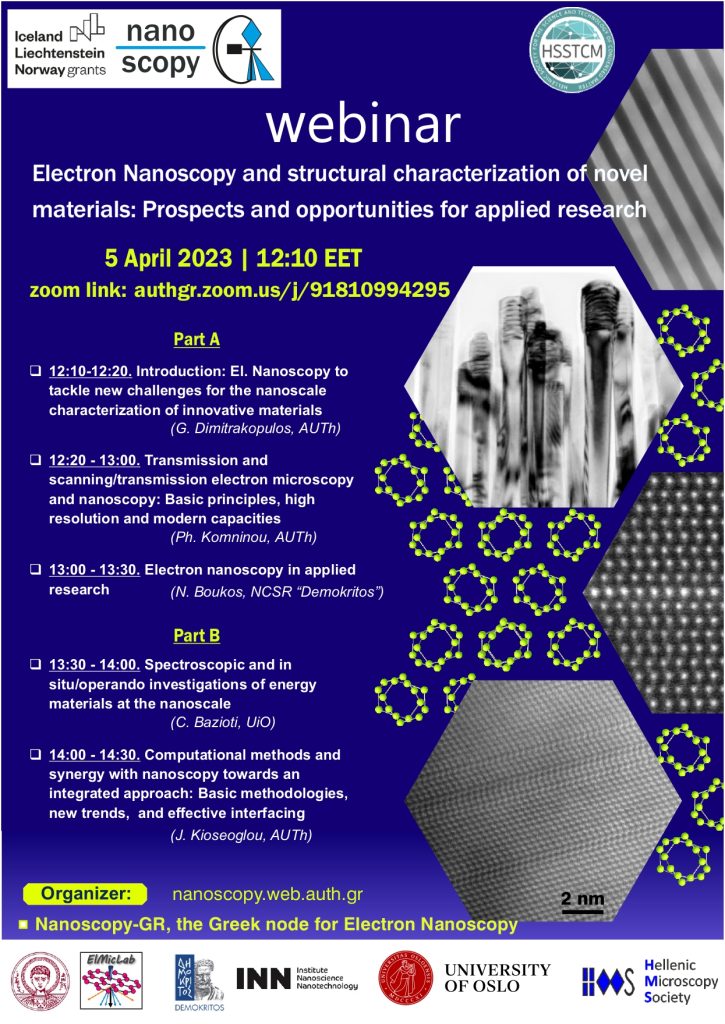
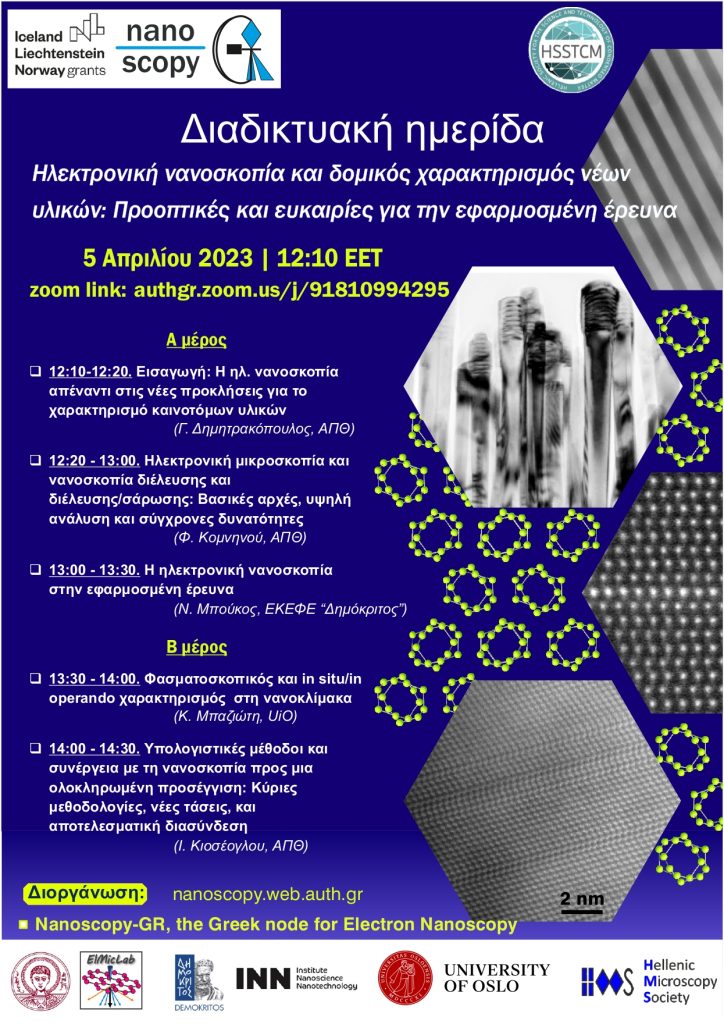
Our first post
Welcome to our new website. Hope you will find all the required information. For additional…

